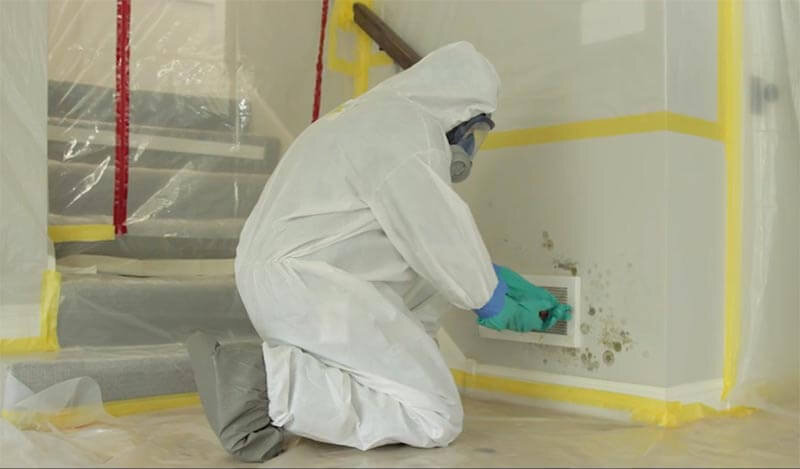Accessing Local Post Remediation Mold Testing Near Me
Your Ultimate Guide to Post Mold And Mildew Remediation Strategies
Browsing the world of post-mold removal techniques is a precise process that requires focus to information and a detailed understanding of the ins and outs included. In the results of mold and mildew invasion, recognizing exactly how to successfully eradicate the mold and mildew and avoid its reoccurrence is critical for preserving a healthy indoor environment. From selecting the best cleansing and decontaminating approaches to implementing techniques for long-term mold prevention, each step in the remediation trip plays a critical function in ensuring an effective result. As we embark on this expedition of post-mold removal techniques, we will certainly discover the key approaches and finest practices that can aid you restore your area to its pre-mold condition and safeguard it versus future mold hazards.
Recognizing Post-Mold Remediation Process
After completing the mold remediation process, it is critical to recognize the post-mold remediation techniques that are required to make certain a effective and extensive clean-up. As soon as the mold and mildew has actually been gotten rid of, the following step entails cleaning and decontaminating the affected locations to stop any kind of regrowth of mold. This includes using specialized cleaning representatives to clean down surfaces and kill any continuing to be mold and mildew spores. It is necessary to dry the area entirely to inhibit the development of mold in the future (After mold remediation). Correct air flow and dehumidification can help in this process.
Moreover, performing a final assessment post-remediation is crucial to make sure that all mold and mildew has been efficiently gotten rid of. If the examination reveals any kind of lingering mold, additional remediation may be needed.
Reliable Cleansing and Decontaminating Methods

Preventing Future Mold And Mildew Development

Importance of Appropriate Air Flow
Proper ventilation plays a crucial function in avoiding wetness accumulation, an essential consider mold growth within interior atmospheres. Efficient air flow systems assist remove excess moisture from the air, minimizing the opportunities of mold and mildew spores discovering the moisture they need to germinate and spread out. Without appropriate ventilation, indoor rooms can come to be a breeding place for mold, causing possible health risks and structural damages.
By making certain correct air flow, ventilation systems can also assist in drying out damp locations faster after water damage or flooding cases, better hindering mold and mildew development. Post Mold Remediation. In rooms like bathrooms, attic rooms, cellars, and kitchens where wetness degrees tend to be greater, installing and preserving reliable ventilation systems is critical in stopping mold and mildew invasions

Tracking and Upkeep Tips
Offered the critical role that appropriate air flow plays in preventing mold and mildew development, it is necessary to establish reliable surveillance and maintenance suggestions to ensure the ongoing functionality of air flow systems. Regular assessments of ventilation systems should be performed to look for any type of indicators of obstructions, leaks, or malfunctions that might impede correct air flow. Tracking humidity levels within the residential property is likewise critical, as high moisture can contribute to mold growth. Setting up a hygrometer can help track humidity levels and sharp house owners to any spikes that may require attention. Additionally, guaranteeing that air filters are on a regular basis cleaned up or replaced is essential for maintaining the performance of the ventilation system. Executing a schedule for regular upkeep tasks, such as duct cleaning home and a/c system examinations, can assist stop issues before they intensify. By staying attentive and positive to the condition of ventilation systems, residential property proprietors can efficiently alleviate the threat of mold regrowth and preserve a healthy and balanced indoor atmosphere.
Conclusion
To conclude, post-mold remediation techniques are important for ensuring a risk-free and clean environment. Comprehending the process, executing efficient cleaning and sanitizing techniques, stopping future mold and mildew development, preserving correct air flow, and see it here routine tracking are all critical steps in the remediation process. By complying with these standards, you can effectively get rid of mold and stop its return, functioning or promoting a healthy and balanced living room for all occupants.
In the results of mold and mildew problem, understanding how to properly eliminate the mold and mildew and avoid its reoccurrence is paramount for keeping a healthy interior setting. Once the mold and mildew has been removed, the following step involves cleansing and decontaminating the influenced locations to protect against any kind of regrowth of mold and mildew - Post Remediation Inspection near me. After eliminating visible mold and mildew development, it is critical to cleanse all surface areas in the damaged area to eliminate any remaining mold spores. To additionally enhance mold and mildew avoidance measures, it is vital to attend to underlying issues that at first led to mold growth.Given the vital duty that proper air flow plays in preventing mold development, it is critical to establish efficient surveillance and maintenance pointers to ensure the continued performance of air flow systems